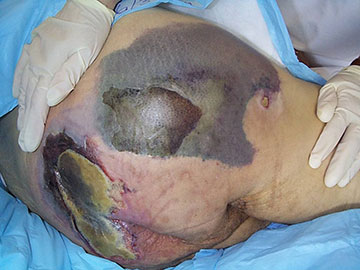AVOIDABLE VS. UNAVOIDABLE PRESSURE INJURIES
Pressure injuries are a global health concern because, for the most part, they are a costly, preventable complication. But are all pressure injuries preventable or avoidable? In the past, clinicians have argued that pressure injuries are not avoidable when the patient is too sick to be turned; when there are more vital organs to worry about than the skin; or when it is too difficult, expensive, or there is not enough staff to implement all preventive measures.
Yet as early as 2000, the U.S. Department of Health and Human Services stated that reducing pressure injury incidence is an objective for all healthcare providers. In 2008, the Centers for Medicare and Medicaid Services (CMS) determined that hospital-acquired conditions could be reasonably prevented with evidence-based guidelines. In support of this determination, CMS stopped reimbursing hospitals for the treatment and care of pressure injuries that were not present on admission.
In 2014, NPIAP (then NPUAP) held a consensus conference on avoidable vs. unavoidable pressure injuries. The following is a summary of the consensus reached:
- Most pressure injuries are avoidable.
- Not all pressure injuries are avoidable.
- There are situations that render pressure injury development unavoidable, including hemodynamic instability that is worsened with physical movement and inability to maintain nutrition and hydration status and the presence of an advance directive prohibiting artificial nutrition/hydration.
- Pressure redistribution surfaces cannot replace turning and repositioning.
- If enough pressure is removed from the external body, the skin cannot always survive.
The definition of avoidable vs. unavoidable pressure injuries was revised to state that:
- An avoidable pressure injury is one that can develop when the provider did not do one or more of the following:
- Evaluate the patient’s clinical condition and pressure injury risk factors
- Define and implement interventions consistent with patient needs, patient goals, and recognized standards of practice
- Monitor and evaluate the impact of the interventions
- Revise the interventions as appropriate
- An unavoidable pressure injury can develop even when a [healthcare] provider does all of the above. Not all pressure injuries are avoidable, because there are patient situations where pressure cannot be relieved and perfusion cannot be improved.
- However, the determination regarding avoidability is made after the fact, when the processes of care can be evaluated. It cannot be predetermined that an unavoidable pressure injury will develop.
Consensus was also reached on the following clinical issues:
- There are some patients in whom pressure injury development is unavoidable. Conditions were identified that may lead to unavoidable pressure injuries (e.g., hemodynamic instability and impaired perfusion); however, these conditions do not make pressure injuries inevitable. The duty to provide care remains.
- There are situations and conditions that limit preventive interventions.
- Skin failure at the end of life is not the same as pressure injuries. Unavoidable pressure injuries and deep tissue injuries may also occur at the end of life, with skin failure, and following cardiac/respiratory arrest.
(Edsberg et al., 2016; WOCN, 2016b)
Thus, the topics discussed in this course—risk assessment, prevention, management, reevaluation, and documentation—are the very factors used to determine if all that can be done for the patient has in fact been done to prevent a pressure injury.
PRESSURE INJURIES AT END OF LIFE
Skin changes or unusual wounds can occur at the end of life and may include deep tissue injury, pressure injuries, or ischemic/mottled wounds. Due to the underlying etiologies, these wounds are generally thought to be unavoidable. For patients at the end of life, it is important to determine the goals of the patient and caregiver(s). Some may wish to achieve healing of the pressure injury, whereas others may desire only palliative care, including reducing pain, odor, drainage, bleeding, and infection, and simplifying dressing changes for comfort. The patient and family must be educated as to realistic expectations for wound healing.
One example of skin changes at the end of life is the Kennedy terminal ulcer. This was first described in 1989. It is located on the sacrococcygeal area. It appears as a purple, red, blue, or black discoloration of the skin with a butterfly or pear shape that has irregular borders. It has a sudden onset, develops rapidly into a full-thickness wound despite appropriate care, and may precede death in days to weeks (WOCN, 2016a).

Terminal ulcer. (Source: C. Melte.)
PRESSURE INJURY PREVENTION TRAINING FOR FACILTY STAFF
Having clinicians who are highly skilled in pressure prevention and treatment is important for all facilities. Equally important is training all staff, licensed or not, in the prevention and recognition of pressure injuries. Care assistants do most hands-on patient care, including bathing, toileting, dressing, and grooming. They are also the patient’s primary source of help for transfers and repositioning.
Setting up facility-wide training programs can be challenging and time consuming. A good resource to consider is the Agency for Healthcare Research and Quality (AHRQ) training program, Pressure Injury Prevention in Hospitals Training Program. This training is used in conjunction with the AHRQ Preventing Pressure Ulcers in Hospitals Toolkit. The goal of the program is to enable hospitals to successfully overcome the obstacles associated with creating, implementing, and maintaining a pressure injury prevention program.
(See “Resources” at the end of this course.)